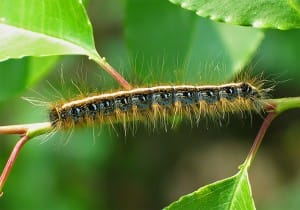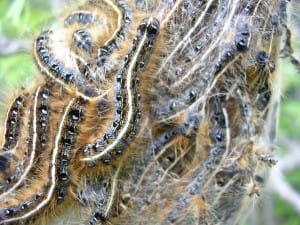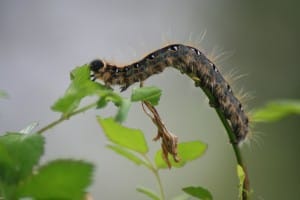Source(s): Jim Howell, Ph.D., Entomologist, The University of Georgia
Ah, the harbingers of Spring have arrived! The Atlanta Braves are playing ball, azaleas and dogwoods are blooming, robins are on the windowsill – and tent caterpillar nests are appearing in our wild cherry trees.
Eastern tent caterpillar eggs are timed to hatch when the cherry buds unfurl, and their rapidly growing silken nests make them an excellent sign for the warming that is just around the corner.
Identification
Older larvae are generally black, with long brown hair and a white stripe down the middle of their backs. Along the midline is a row of blue spots with brown and yellow lines. At maturity, the caterpillars may reach a length of 2 1/2 inches. Adults are reddish-brown, with two white oblique stripes on each forewing.
Biology
Adult moths emerge in May and early June and lay egg masses that resemble chocolate-colored collars that encircle the smaller limbs of their host. Each egg mass is about 1 inch long. Eggs overwinter and hatch in mid-March of the following year, at the same time the cherry buds unfurl. The appearance of new, tender leaves is like the ringing of a dinner bell.
From each case, several hundred tiny feeding machines emerge, and for four to six weeks they hungrily strip the trees of their leaves. The larvae are gregarious and upon hatching they gather in the forks of the limbs. Usually one of these tents or “colonies” is made of insects hatching from several different egg masses.
From this mass of silk, the developing larvae move outward to feed on developing leaves. They produce a fine thread of silk that is laid down wherever they crawl, and in a few days, well-defined pathways can be seen leading from the nest to various feeding sites in the tree.
Most of the larvae return to the tent at night or during rainy weather and the nest gradually becomes larger and larger as silk accumulates. Most of the leaf is consumed, leaving only the mid-vein.
About three weeks later, the adult moths emerge, mate and lay their eggs, which stay on the trees until the following spring, when the process begins again.
Though the nests are most commonly seen in the forks of wild cherries, this pest can be found in other ornamental, shade and fruit trees, especially apples. While not a serious pest in the natural forest, this insect can be a blight to homeowners because the infestations reduce the beauty and esthetic value of shade trees and other hardwoods in the landscape.
Damage
The large silken masses are unsightly in the forks of trees. In addition, about four to six weeks after hatching, full-grown larvae will crawl away from their nests and accumulate on the sides of homes, on driveways and sidewalks and on various woody ornamentals in search of pupation sites.
At this time, homeowners express concern about possible damage to other plants. But by now, the larvae are finished with their feeding and will do no damage to plants on which they are found. Their white cocoons are usually spun on tree trunks or nearby objects.
The caterpillars are primarily a nuisance and do not usually pose a danger to the overall health of larger, well-established tree. Young fruit and ornamental trees may be damaged, however.
The larvae finish their feeding at a time of vigorous leafing activity, and though the trees are often stripped of their leaves, they usually produce a new flush of foliage within two or three weeks.
Control
Usually, no controls are necessary. But should caterpillars attack young trees and for aesthetic preservation, the nests, along with their accompanying larvae, can be removed and destroyed. In addition, the egg masses can be clipped from the limbs in late June to prevent nests from developing the following spring. For chemical controls, explore the “Georgia Pest Management Handbook“.
Center Publication Number: 176
- Icky Silverfish are Generally Harmless - September 24, 2013
- Menacing Mice - September 24, 2013
- Opossum Damage and Control - September 24, 2013


